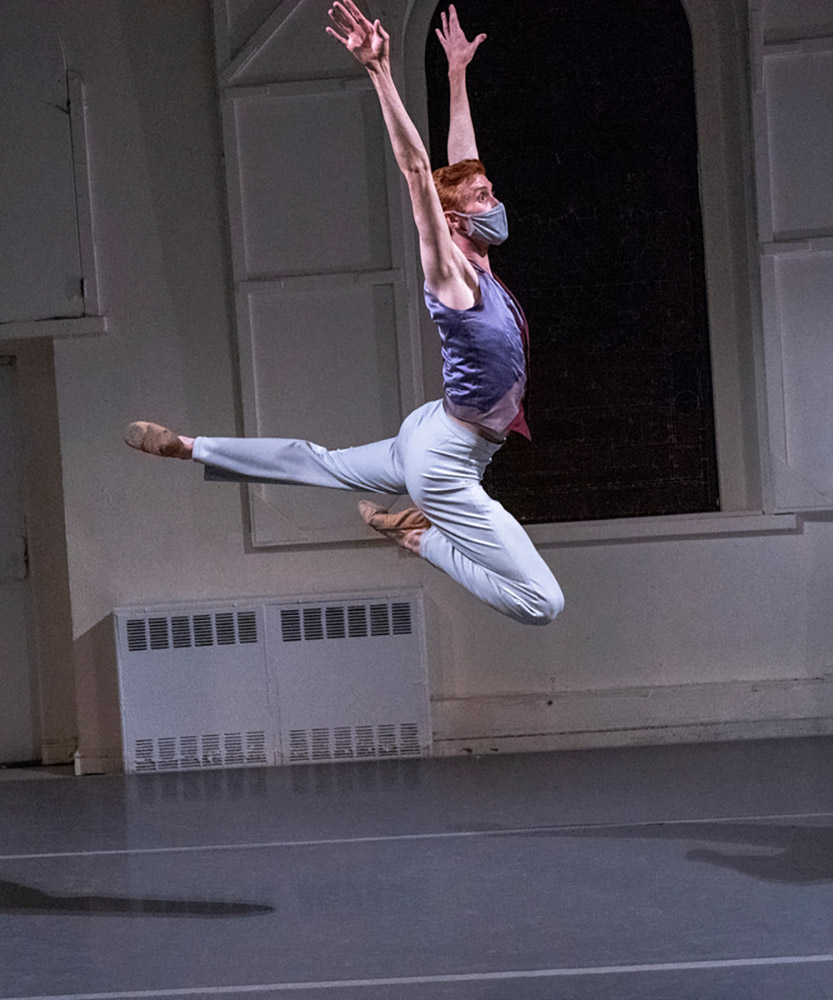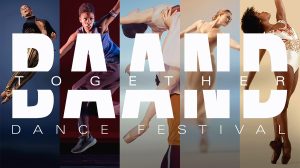
© Richard Termine. (Click image for larger version)
New York Theatre Ballet
Spring Lift Lab Live – Program D: Suite from Mazurkas, Size of the Sky, Wind-Up, Mamborama, Displacement, A Brother Distant
★★★★✰
New York, New York Theatre Ballet studio, St. Marks Church-in-the-Bowery
15 April 2021
nytb.org
In the Upper Room
While large theaters in New York remain closed, it has been the smaller organizations that have shown the most enterprising spirit during the pandemic. New York Theatre Ballet, led by Diana Byer, has been a quiet beacon, not just persevering, but commissioning new works for live performance at the company’s studio in the East Village, as far back as last fall.
The dances are solos, duets, or, in some cases small ensembles for up to five or six dancers; some, but not all, have been either staged or choreographed via Zoom. The dancers perform while wearing masks – but who even notices masks anymore? And the audience is limited to ten, well-spaced people, separated by see-through plastic barriers. But there is live musical accompaniment on the piano, and the space itself, located on the second floor of the complex of St. Marks Church-in-the-Bowery, is pleasant, with high ceilings and stained glass.

© Richard Termine. (Click image for larger version)
The programs are a mix of revivals (the one I saw, Program D, included an excerpt of a work by José Limón) and new works, many by company-members or up-and coming choreographers. Byer has also developed a close relationship with the British choreographer Richard Alston, who, especially since losing his own company in the UK, has frequently created or recreated pieces for NYTB’s dancers. This program closed with Alston’s A Brother Distant, a reworking of an earlier piece, Fingerprint, from 2007. This touching ensemble work, inspired by the story of Bach’s separation from his brother Jakob at the age of fourteen, made use of six dancers, and ended, poetically, with one of them facing away from the others, waving into the distance. The music was by Bach.
A Brother Distant may have been the most substantial work, but there were other pleasures to be had. Chief among them, a short duet by James Whiteside, a principal dancer at American Ballet Theater who has lately been branching out into choreography. (He also has a drag persona, writes pop music, and has a memoir coming out, Center Center.) The duet, Mamborama, is a witty, tongue-in-cheek little number for two women on pointe, set to Tito Puente. It’s pure camp, performed deadpan by two ladies (Mónica Lima and Amanda Treiber) in sparkly costumes and masks onto which pouty, sequined lips have been appliqued. They shake their hips, do quick, syncopated footwork on pointe, while stylishly waving their arms or holding them like paws. What Mamborama reacalls most is the “Popular Song” in Frederick Ashton’s suite Façade. It would be great to see Whiteside develop it into his own suite of witty set pieces.

© Richard Termine. (Click image for larger version)
There were more new creations, two from company dancers. Amanda Treiber’s Wind-Up deserves the prize for most charming musical choice, Ryan Anthony Francis’s Wind-Up Bird Preludes, a playful piece with allusions to The Magic Flute and Barber of Seville, as well as the sounds of chirping birds. (Also, loveliest costumes: simple, with the back exposed.) Treiber appeared to be experimenting with different dance qualities: darting, staccato, sculptural and precise; in one motif, a tendu was combined with arms held above the head in a graceful couronne (crown-shape). It evoked the essence of balletic composure. In one section three women and one man danced in and out of unison, shuffling the deck of mathematical combinations: three and one, two and two, all four. There was a whiff of Merce Cunningham as well, in the tilted bodies, led by the head.
Another new work, Julian Donahue’s Displacement, was a pensive duet for two women who often seemed to be consoling or protecting each other. Size of the Sky, by Nicolo Fonte (not a member of the company) was a solo for Julian Donahue, in which he twisted an untwisted his slender frame, shielding his eyes from a bright light, to a score for prepared piano by Kelly Moran.

© Richard Termine. (Click image for larger version)
The excerpts from Limon’s Mazurkas were suitably solemn and sculptural. I especially enjoyed Opus 41 no. 3, a pas de deux in which Giulia Faria and Julian Donohue swept each other up into buoyant jumps, legs held in a V shape (in the last version of the motif, the jumps are bigger, the legs almost in a split).
It is a pleasure to watch dance in this spare, airy studio, without fanfare or elaborate production values. In fact, the whole experience of watching dance in this way feels somehow private, as if the dancers were performing just for you. It’s wonderfully intimate. And though I’ll be happy to return to theaters and the company of hundreds or thousands of fellow audience-members, there is something to be cherished about this transitory moment in which people like Diana Byer and her dancers and musicians are making the best of things, for the pleasure of those lucky few who make it up the steps of St. Marks.

















NYTB is a gem to be treasured. It helps make NYC a remarkable place to be… Thanks to its loyal donors who know a good thing when they see it and enable it and Diana Byer to keep going.